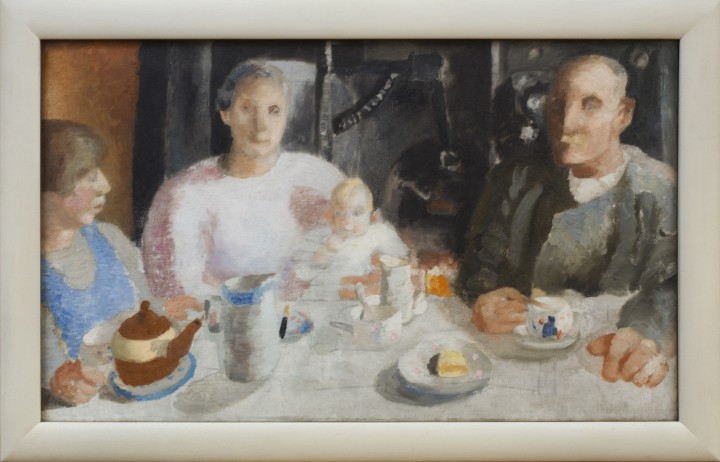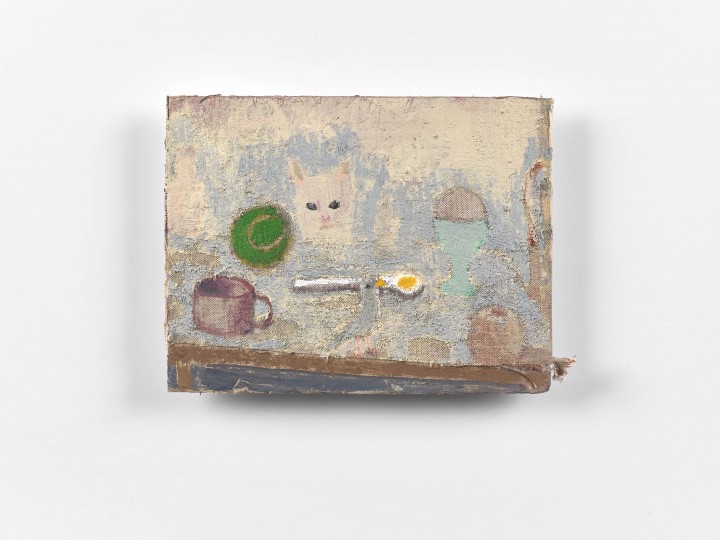Scottish Art News
Latest news
Magazine
News & Press
Publications
Dreams of the everyday: paintings by Winifred Nicholson & Andrew Cranston
By Greg Thomas, 04.07.2025
 tiny signs_2021_distemper on canvas_180 x 140 x 3.5 cm canvas_press.jpg)
The titles of Andrew Cranston’s paintings sometimes contain puns or unexpected allusions that push the work into new perspectives—just as his placement of objects and details can suggest viewing angles gently nudging against each other. One of the most disarming titles in Cranston and Winifred Nicholson’s current double-header at Stromness’s Pier Arts Centre is: '(This infinitesimal twinkling of) tiny signs'. This painting of Cranston’s, from 2021, is a still life of sorts. An abundance of objects in the foreground brings the everyday into easy conversation with the fantastical. Here is a little polka-dot jug, there a coiled, speckled snake: real or toy? We cannot be sure. Beyond is an expanse of pale ochre that fills most of the frame. Are we on a balcony looking out over an expressionist skyscape? Or are we inside, our vision pulled up short against a wall that seems to give way to porous depths?
The twinkling of tiny signs. The phrase might partly suggest the arrangement of objects in space. Cranston refers to Lowry in the text accompanying the show, perhaps inviting us to imagine this gathering of spindly domestic curios as a bustling, miniature city-scape, each inhabitant with a distinct character and back story: a sign for a hidden life, as it were. But does the title also have something to do with how the passage of time is dramatised in Cranston’s art? The accretion of things, and of jostling viewing positions, suggests a scene returned to again and again, new themes and details added each time. “I sometimes take the objects from other paintings, like Spanish still lifes and remembered objects, or memories from films or books, rather than real things”, Cranston says of this work in the exhibition text. Perhaps the twinkling of signs is also the twinkling of time, passing in visible moments on the canvas.
The domestic setting seems particularly potent for work such as Cranston’s which captures this melding of inner and outer reality. (No doubt this has to do with the frequency and habit with which one can return to certain domestic scenes, actions, and relationships over and over again).
 (1).jpg) Winifred Nicholson 'Kate and Jake, Isle of Wight', (1932)/ Courtesy Bristol Museums, Galleries and Archives. © Trustees of Winifred Nicholson
Winifred Nicholson 'Kate and Jake, Isle of Wight', (1932)/ Courtesy Bristol Museums, Galleries and Archives. © Trustees of Winifred Nicholson
The product of an earlier era and scene, Nicholson’s work has less of the anything-goes, dreamlike quality that defines some of Cranston’s pieces. It is more clearly rooted in the scene and moment observed. But in works such as 'Kate and Jake, Isle of Wight' (1932), there is a haziness of tone and a lovely vagueness of outline similar to that found in Cranston’s palette and facture. The aversion to heavy tonal contrasts which renders the right-hand child’s face almost devoid of features, save for her watery, intense blue eyes, suggests a scene only partially seen or recalled—liable to disintegrate into the pale ground.
 Winifred Nicholson 'The Warwick Family' (ca. 1925-26). © Trustees of Winifred Nicholson Image Piano Nobile
Winifred Nicholson 'The Warwick Family' (ca. 1925-26). © Trustees of Winifred Nicholson Image Piano Nobile
 Andrew Cranston, 'Ever get the feeling you've been cheated?' (2022). Photograph John McKenzie Image courtesy of the artist and Ingleby Gallery
Andrew Cranston, 'Ever get the feeling you've been cheated?' (2022). Photograph John McKenzie Image courtesy of the artist and Ingleby Gallery
So too, there is a palpable impression of multiple moments recorded on the canvas in the way Nicholson gently plays with perspective, just as there is with Cranston. In an interesting conversation between Cranston, Richard Ingleby, and guest co-curator Jonathan Anderson (a feted contemporary designer) included with the gallery text, Anderson talks about how the idea for the current show came to him. He had been looking at 'The Warwick Family' (ca. 1925-26), Nicholson’s breakfast-table portrait of parents and a child. In this piece, Anderson notes, the black flash of a butter-knife handle drags you into the odd perspective of the table by forcing it out of perspective. Similarly, in Cranston’s painting 'Ever get the feeling you've been cheated?' (2022), the black eyes of a cat gazing resentfully at a boiled egg seem both the centre of gravity for the work and to drag it off centre. In both cases, because of the domestic setting, the familiar post-Cubist trope of a fractured picture plane suggests not so much an analytical device as an intimate memory returned to again and again.
.jpg) Winifred Nicholson 'Bathtime' (c. 1934). Courtesy Tullie House Museum & Art Gallery Trust. © Trustees of Winifred Nicholson
Winifred Nicholson 'Bathtime' (c. 1934). Courtesy Tullie House Museum & Art Gallery Trust. © Trustees of Winifred Nicholson
The arrangement of paintings in this exhibition offers whimsical connections between the two artists’ themes and scenes. Two beautiful works, Nicholson’s 'Bathtime' (c. 1934) and Cranston’s 'Dreams of the everyday' (2018), are alike not just in their watery settings but in their references to family and childhood. Cranston’s 'Reader' (2018) and Nicholson’s 'Portrait of A Lady' (n.d.) recall the classic domestic portraiture of Berthe Morisot and other French Post-Impressionists. For those who can’t make the trip to Orkney for this Ingleby-presented show, a slim and stylish book co-published by Ingleby and 5b, Glasgow, offers a visit in spirit. Plunge into the everyday.
Dreams of the everyday: paintings by Winifred Nicholson & Andrew Cranston is exhibited at The Pier Arts Centre, Stromness until 13th September 2025. It then travels to The Holburne Museum in Bath, 3rd October - 11th January 2026.




